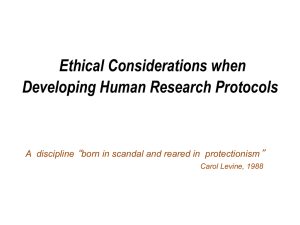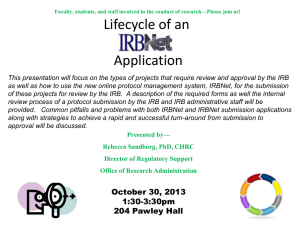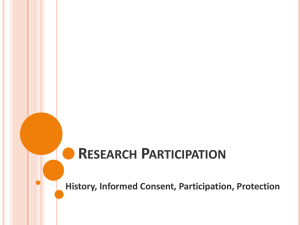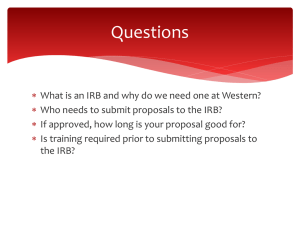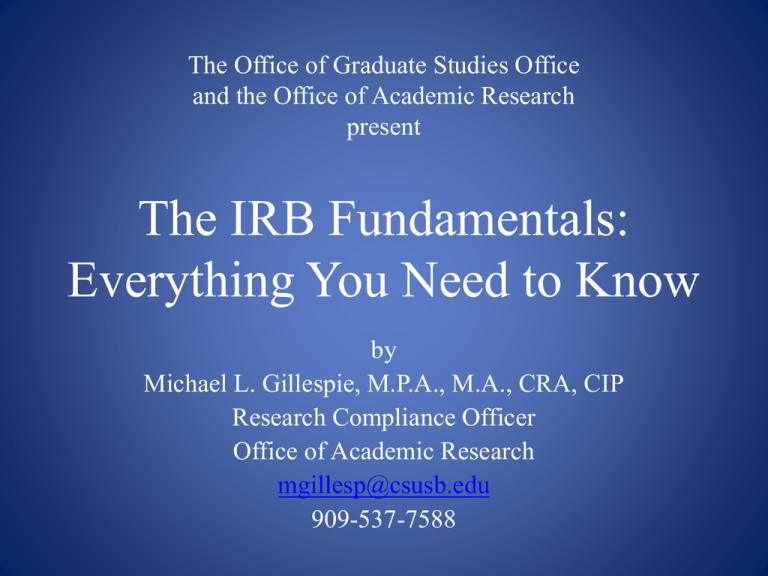
The Office of Graduate Studies Office
and the Office of Academic Research
present
The IRB Fundamentals:
Everything You Need to Know
by
Michael L. Gillespie, M.P.A., M.A., CRA, CIP
Research Compliance Officer
Office of Academic Research
mgillesp@csusb.edu
909-537-7588
Goals and Objectives
• Workshop Topics
– Why we have the IRB?
– What is human subjects (participants) research?
– The Belmont Report
– The IRB Application Process
– Ethical Considerations
– Research Misconduct
– It’s Your Time for Questions and Answers!
Why we have the IRB?
• IRB derives from Medical Research without
informed consent
– Nuremburg Code – Nazi experimentation on humans –
cruel, inhumane treatment, harm
– Tuskegee syphilis experiment 1932 – 1972
• No Informed Consent
• “The study initially involved 600 black men – 399 with
syphilis, 201 who did not have the disease.”
• “Researchers told the men they were being treated for "bad
blood," a local term used to describe several ailments,
including syphilis, anemia, and fatigue. In truth, they did not
receive the proper treatment needed to cure their illness. In
exchange for taking part in the study, the men received free
medical exams, free meals, and burial insurance. Although
originally projected to last 6 months, the study actually went
on for 40 years.”
Why we have the IRB?
• IRB protections moved from medical research
to include social behavioral research due to:
– Milgram experiment in 1961 conducted by Stanley
Milgram of Yale University – focusing on the conflict
between obedience to authority and personal conscience.
Related to Nuremburg trials and German soldiers and
doctors justifying their action as “just following orders.”
– http://www.youtube.com/watch?v=xOYLCy5PVgM
Why we have the IRB?
• Another famous/infamous social experiment
– Stanford Prison Experiment
– 1971 study that asked, “What happens when you put good
people in an evil place? Does humanity win over evil, or
does evil triumph?
– Another obedience to authority study
• You can view various documentaries on Youtube.
https://www.youtube.com/results?search_query=stanfor
d+prison+experiment+documentary
Why we have the IRB?
• Federal regulation establishes the requirements for
Institutional Review Boards, informed consent, benefitrisk assessment, and subject selection
• Common Rule (45 CFR 46)
• FDA (Title 21)
• Individual Professional Codes of Ethics and Conduct
• CSUSB Faculty Senate Policy (FAM 845.72) defines
authorities, roles, and responsibilities of the CSUSB
faculty and the Institutional Review Board
• CSUSB Federalwide Assurance filing (2003) FWA
000004865 for the Protection of Human Subjects in
Research describes the measures CSUSB will take
• CSU Chancellor Executive Letter 890
• CSUSB Policy – Faculty and Student Misconduct Policy
Federal definition of human subjects
• Research means a systematic investigation, including research
development, testing and evaluation, designed to develop or
contribute to generalizable knowledge. Activities which meet
this definition constitute research for purposes of this policy,
whether or not they are conducted or supported under a
program which is considered research for other purposes. For
example, some demonstration and service programs may
include research activities.
• Human subject means a living individual about whom an
investigator (whether professional or student) conducting
research obtains
–
–
(1) Data through intervention or interaction with the individual,
or
(2) Identifiable private information.
What is human subjects research?
Federal definition of an intervention with a human subject is:
• Intervention includes both physical procedures by which data are
gathered (for example, venipuncture) and manipulations of the
subject or the subject's environment that are performed for
research purposes. Interaction includes communication or
interpersonal contact between investigator and subject. Private
information includes information about behavior that occurs in a
context in which an individual can reasonably expect that no
observation or recording is taking place, and information which has
been provided for specific purposes by an individual and which the
individual can reasonably expect will not be made public (for
example, a medical record). Private information must be individually
identifiable (i.e., the identity of the subject is or may readily be
ascertained by the investigator or associated with the information)
in order for obtaining the information to constitute research
involving human subjects.
Why we have the IRB?
• CSUSB’s Federalwide Assurance
– We will apply the Belmont Report principles to all human
subjects research regardless of funding.
– Federal rules will apply whenever CSUSB becomes
engaged in human subjects research or the IRB provides
review and oversight of federally funded research.
– We will comply with Title 45 Code of Federal Regulations
Part 46 (45 CFR 46) and Subparts B, C, and D (children,
prisoners, pregnant women, fetuses, and embryos).
– Unless exempted all research requires written informed
consent.
– We will train and certify all university officials and
researchers – CITI Human Subjects Training
– The university will provide adequate resources to IRB.
Human Subjects Include
• Persons
– First person and third person reporting
• Data about persons, including secondary data.
– Non-electronic
– Electronic
– Images
– Recordings
• Biological samples drawn from persons
– Fluids, tissues, scrapings
– Genetic encoding
Title 45 Code of Federal Regulations
Part 46 (45 CFR 46)
• Defines “research.”
• Defines “human subject.”
• Provides regulatory requirements for
institutional review boards’ (IRB) structure
and processes.
• Defines elements of informed consent.
• Establishes categories of IRB review.
• Defines exempt and nonexempt research.
The Belmont Report
• “In July 12, 1974, the National Research Act (Pub. L. 93-348)
was signed into law, there-by creating the National
Commission for the Protection of Human Subjects of
Biomedical and Behavioral Research. One of the charges to
the Commission was to identify the basic ethical principles
that should underlie the conduct of biomedical and behavioral
research involving human subjects and to develop guidelines
which should be followed to assure that such research is
conducted in accordance with those principles. In carrying out
the above, the Commission was directed to consider: (i) the
boundaries between biomedical and behavioral research and
the accepted and routine practice of medicine, (ii) the role of
assessment of risk-benefit criteria in the determination of the
appropriateness of research involving human subjects, (iii)
appropriate guidelines for the selection of human subjects for
participation in such research and (iv) the nature and definition
of informed consent in various research settings. The Belmont
Report attempts to summarize the basic ethical principles
discussed by the commission.”
The Belmont Report Basic
Ethical Principles
• Respect for Persons:
– “Respect for persons incorporates at least two
ethical convictions: first, that individuals should be
treated as autonomous agents, and second, that
persons with diminished autonomy are entitled to
protection. The principle of respect for persons thus
divides into two separate moral requirements: the
requirement to acknowledge autonomy and the
requirement to protect those with diminished
autonomy.”
The Belmont Report Basic
Ethical Principles
• Beneficence:
– Persons are treated in an ethical manner not only by
respecting their decisions and protecting them from
harm, but also by making efforts to secure their wellbeing. Such treatment falls under the principle of
beneficence. The term "beneficence" is often
understood to cover acts of kindness or charity that
go beyond strict obligation. In this document,
beneficence is understood in a stronger sense, as an
obligation. Two general rules have been formulated as
complementary expressions of beneficent actions in
this sense: (1) do not harm and (2) maximize possible
benefits and minimize possible harms.
• The Hippocratic maxim (Oath) "do no harm" has
long been a fundamental principle of medical
ethics.
The Belmont Report Basic
Ethical Principles
• Justice:
– “Who ought to receive the benefits of research and
bear its burdens? This is a question of justice, in the
sense of "fairness in distribution" or "what is
deserved. There are several widely accepted
formulations of just ways to distribute burdens and
benefits. Each formulation mentions some relevant
property on the basis of which burdens and benefits
should be distributed. These formulations are (1) to
each person an equal share, (2) to each person
according to individual need, (3) to each person
according to individual effort, (4) to each person
according to societal contribution, and (5) to each
person according to merit.”
The Belmont Report Basic
Ethical Principles
• Justice (continued):
– For example, during the 19th and early 20th centuries
the burdens of serving as research subjects fell largely
upon poor ward patients, while the benefits of
improved medical care flowed primarily to private
patients. Subsequently, the exploitation of unwilling
prisoners as research subjects in Nazi concentration
camps was condemned as a particularly flagrant
injustice. In this country, in the 1940's, the Tuskegee
syphilis study used disadvantaged, rural black men to
study the untreated course of a disease that is by no
means confined to that population. These subjects
were deprived of demonstrably effective treatment in
order not to interrupt the project, long after such
treatment became generally available.
45 CFR 46 PARTS B, C, D
Vulnerable Populations
• Know your study population and especially if
they are vulnerable populations afforded
additional federal protections.
– Subpart B. Pregnant Women, Fetuses and
Embryos
– Subpart C. Prisoners
– Subpart D. Children
– Those with impaired decision and mental
capabilities, groups that are stigmatized and
marginalized, and the economically and socially
disadvantaged may also qualify as vulnerable.
The IRB Application Process
The IRB Review Process
• The IRB weighs the risks and benefits of the
research study. Do the risks outweigh the
benefits? If so, the IRB attempts to help the
researcher(s) minimize those risks and asks for
revisions. Those revisions are provided to you
through email correspondence.
• Make yourself familiar with the IRB website.
Training, Submission Dates, Application, &
Resources that are available.
– http://irb.csusb.edu
The IRB Application Process
The IRB Review Process
• Application:
– The 3 C’s: Is it clear, concise, and coherent.
– Use language the IRB can understand.
– If your using specific words, acronyms, abbreviations,
related to your college/department/program
discipline make sure to define and spell those out for
the IRB.
– Explain your research methods clearly and how you
will apply them (procedures you will follow).
– The reviewers like step-by-step processes and
procedures. Again, make sure they are 3 C’s.
Recruitment of Participants
• Describe sources of potential participants,
how they will be selected and recruited, and
how and where you will contact them.
Include all relevant characteristics with regard
to age, ethnicity, sex, institutional status (i.e.,
patients or prisoners), and general state of
physical and mental health (i.e., know the
demographics of your population).
– Pay close attention to those that are described as
a protected population (subpart B, C, and D).
Description of the Project
• Briefly describe the objectives and methodology of your
research (including hypothesis and/or research
questions), data collection procedures, and features of
the research design that involve specific procedures or
special conditions for participants (including frequency,
duration, and location of participation. It is helpful to
the IRB to divide up the project description into the
categories below.
a.
b.
c.
d.
e.
f.
Objectives of the Study
Hypothesis
Methodology
Data Collection
Data Analysis
Dissemination
Confidentiality of Data
• Clearly indicate specific procedures (e.g., coding
of responses, aggregate reporting, etc.) to
protect the confidentiality of participants and
safeguard identifiable records and data. This
includes safe and secure storage of the collected
information and when the data will be
destroyed after the data collection process has
been completed. If not possible, state why.
Confidentiality of Data
• Safeguarding the data from unauthorized access can be
accomplished in various ways:
– Collect data without identifiers
– Remove all direct identifiers as soon as possible
– Substitute codes or pseudonyms for identifiers
– Maintain code lists ("keys") and data files in separate
secure locations
– Use accepted methods to protect against indirect
identification, such as aggregate reporting or
misleading identifiers
– Use and protect computer passwords
– Access and store data on computers without Internet
connections
– Encrypt data
Privacy Rights and Research
• Private information
– includes information about behavior that occurs in a
context in which an individual can reasonably expect
that no observation or recording is taking place, and
information which has been provided for specific
purposes by an individual and which the individual
can reasonably expect will not be made public (for
example, a medical record or student record).
– Anonymous, confidential, private, and personally
identifiable may have different operational meanings
in different research protocols, data formats, and
under federal and state laws.
Risks in Research
IRB Review and Risks and Benefits
– Assessment of Risks and Benefits
• Little to no risk, minimal risk, more than minimal risk
– Informed Consent Process
– Selection of Subjects and Protection of Vulnerable
Populations
• Nature of Risk
– Concept of Minimal Risk
– Nature of Harm
• Minimal risk means that the probability and magnitude
of harm or discomfort anticipated in the research are not
greater in and of themselves than those ordinarily
encountered in daily life or during the performance of
routine physical or psychological examinations or tests.
Risks in Research
• IRB weighs the risks related to:
– Harms commensurate with daily life, requiring no
special protection:
– Inconvenience
– Harms that have the potential for serious effects
– Emotional or psychological harm
– Social harm
– Physical harm
– Financial harm
– Legal harm
– Moral harm
Benefit in Research
• Research participation founded on concept of
volunteerism, where no personal benefit, only
societal, is realized.
• Examples of things that are not benefits but
incentives.
– Payments,
– extra credit,
– opportunities for drawings or lotteries,
– health improvement,
– and insights in own self.
Risks and Benefits
• Describe in detail any immediate, short-term, or
long-range risks that may arise for participants as
a result of procedures associated with your study.
Risks may be physical, psychological, social, legal,
or economic; they would include side effects,
risks of placebo, delay in customary treatment,
etc. Indicate any precautions that will be taken to
minimize risks. Also indicate any anticipated
benefits to participants and/or society from the
knowledge that may reasonably be expected to
result from the study.
Levels of IRB Review
Informed Consent
• Required Elements of Informed Consent:
–
–
–
–
–
–
–
–
Purpose and Procedures
Risks
Benefits
Alternatives
Confidentiality
When There is Greater than Minimal Risk
Persons to Contact
You must tell prospective participants whom to
contact if they have questions about the research and
their rights as a study participant, and whom to
contact if they have an injury that may be related to
the research.
Informed Consent
• Voluntary Participation, Refusal, and Withdrawal.
– You must state that participation is voluntary, that
the participant may decline to participate at anytime
with no questions asked, and that there are no loss of
benefits to which the person is otherwise entitled (if
research conducted in a classroom setting that
deciding not to participate will not affect their grade
in any way).
• If classroom assignment remember you must separate the
two (i.e., what is research versus what is required
classroom participation). If the student decides not to
participate then another non research related assignment
must be assigned and their decision honored. The alternate
assignment may be another normal non-research related
classroom activity.
Ethical Considerations
Issues of Volunteerism
• Fundamental Ethical Principle
• Use of students as subjects problematic –
review your discipline’s ethical statements.
• Be sensitive to subtle coercion.
• Provide alternative activities and rewards for
students.
• Build into protocol regular checks on subject’s
willingness to continue.
Ethical Considerations
• Remember that consent is an ongoing process. If
the protocol last longer than 6 months it is always
a good idea to go over the consent again and ask
if they have any questions. If participant asks
then your ethically obligated to go over consent
again.
• Consent required 3 critical items.
– Information: Elements of informed Consent
– Comprehension: Understandable language at the
participants reading and comprehension level. Also
includes language translations
– Voluntariness: Right to agree or not to agree to
participate
Research Misconduct
• Remember that there is a Faculty and Student
research misconduct policy.
– Research Misconduct includes:
• Fabrication,
• Falsification,
• And Plagiarism.
• CSU/CSUSB polices and regulations along with
federal regulations located at:
• http://irb.csusb.edu/policiesRegulations.html
Researcher Responsibilities
• Plan ahead!
• Provide evidence of certification in human resources protection
from CSUSB – CITI Human Subjects Training.
• You must not deviate from protocol once approved. Deviations
from the protocol require IRB approval before they can be
implemented in your study (protocol change form required).
• Only stamped informed consent document may be used.
• Changes in investigators or funding requires notification to IRB.
• Must notify IRB of project ending or of need for continuation.
• Annual continuing review and approval must be obtained.
• Must notify Research Compliance Officer and IRB Chair of any
unanticipated adverse events.
Student Research Supervisors
• You are responsible party, not the student.
• Plan ahead!
• Incorporate ethical discussion into research
planning.
• Be knowledgeable of all relevant policies,
laws, and regulations applicable to student’s
methodology.
• Review IRB application with student before
signing.
Editing and Proofreading
• Remember to edit and proofread the application
before submitting. Ensure that your advisor reads
and reviews the entire application. This is critical
to the review of your application.
– The IRB’s mission is to review the risks and benefits of
your protocol not edit it. Editing distracts from the
review of your protocol.
– It is highly recommended to have another person
besides your advisor review your protocol. This could
be a cohort colleague, another faculty member, or a
fellow student.
It’s Your Time for Questions and
Answers!
References
YouTube Milgram (October 27, 2014). Milgram Experiment: Experiment - Big History NL, threshold 6.
Retrieved from http://www.youtube.com/watch?v=xOYLCy5PVgM.
Zambardo, P., (October 27, 2014). Stanford Prison Experiment. Retrieved from http://www.prisonexp.org/.
Centers for Disease Control and Prevention (October 27, 2014). Tuskegee Syphilis Experiment. Retrieved
from http://www.cdc.gov/tuskegee/timeline.htm.
Office of Human Research Protections (October 27, 2014). Code of Federal Regulations. Retrieved from
http://www.hhs.gov/ohrp/humansubjects/guidance/45cfr46.html#46.102
U.S. Department of Health and Human Services (October 27, 2014). The Belmont Report. Retrieved from
http://www.hhs.gov/ohrp/humansubjects/guidance/belmont.html.
University of Southern California (October 28, 2014). ORPS Office Types of IRB Review. Retrieved from
http://oprs.usc.edu/review/typesofirb/ .
San Francisco State University (October 28, 2014). The IRB Review Process at a Glance. Retrieved from
http://research.sfsu.edu/protocol/review_process/review_process.
Joseph. L., (October 27, 2014). Protection of Human Research in Research Workshop 2005. Portions of
Powerpoint derived from former CSUSB IRB Chair, Dr. Joseph Lovett, Ph.D.

